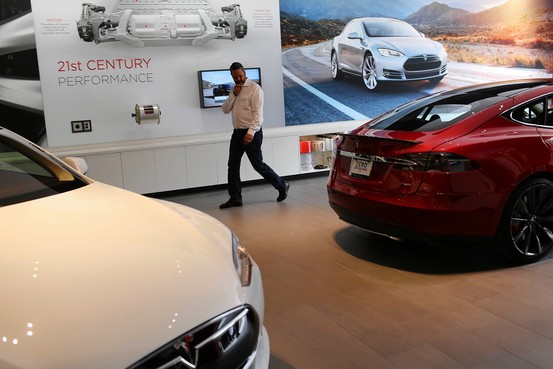
Tesla Looking at California as Site for Battery Factory
Tesla Motors Inc. is taking a closer look at California to build a giant electric-car battery factory after state lawmakers proposed new tax breaks and regulatory changes that could speed its construction and lower costs.
California is already the auto maker’s corporate headquarters and where it builds its $71,000 and up electric cars. But the company in February had omitted the state from a list of potential sites for a new plant, which would build advanced batteries for its electric vehicles.
Winning the Tesla battery factory would come at a critical time for California. In April, Toyota Motor Corp. decided to move its headquarters to Plano, Texas, after spending decades in suburban Los Angeles.
Tesla’s proposed 10-million-square-foot plant could employ up to 6,500 people when finished and cost up to $5 billion. Landing that whale would help reverse the perception that California isn’t a competitive market for manufacturers.
Tesla CEO Elon Musk abandoned his plans to name the entry-level electric car, that’s expected to hit markets in 2017, Model E after Ford threatened to sue. MarketWatch’s Jim Jelter explains why this means no SEX for Tesla.
“California has set into play various legislative proposals and actions that have enabled it to come back into consideration,” a Tesla spokesman said. “Discussions have taken place between us and various representatives of the state and the overtures they are making and conditions they are proposing place them in a better position for consideration.”
The state last week authorized local property tax breaks for battery plants. On Thursday, Gov. Jerry Brown signed a bill authorizing a $420 million tax credit for Lockheed Martin Corp. that included language also allowing local governments to offer property tax breaks to battery manufacturers, essentially creating a pathway for Tesla’s gigafactory.
Separately, State Senators Ted Gaines, R-Roseville, and Darrell Steinberg, D-Sacramento, proposed a bill with placeholder language that refers to an economic development project involving a battery factory. The legislators are working the state’s economic development department and Tesla to come up with a list of requirements to try to get the bill through the legislature when the session restarts in August.
Tesla initially named Arizona, Nevada, New Mexico and Texas as the states under consideration. But site selection has been ongoing for six months, allowing California to nudge in.
“I will do everything in my power to have California land this factory,” Sen. Gaines said. “It’s very important for California and sends a message across the country that we are open for business.”
Tesla now employs 6,000 people in the state, spread among its Palo Alto headquarters, Fremont assembly plant and other retail and small manufacturing sites.
The company has said it would begin construction at more than one locations before picking a final spot. At its annual meeting, Chief Executive Officer Elon Musk said that the company may wait until the end of the year for a final decision.
It is important that the company start soon in order to complete the factory by 2017, when it plans to roll out its third vehicle, an electric car called the Model III that it aims to start selling at $35,000 with a 200-mile range.
The range would be about double what existing EVs at that price can achieve and most of that improvement is based on the cost savings coming from building the gigafactory.
Tesla has said it needs between 500 and 1,000 acres for its battery factory. Some of that land would be used for solar and wind-powered electricity generation. Tesla now owns 300 acres adjacent to the Fremont assembly plant. Some politicians have suggested using a portion of Mather Field, a former Air Force base in Rancho Cordova near Sacramento.
New Mexico’s Cabinet Secretary for Economic Development, Jon Barela, said recently the state is still in the running. There have been media reports in Dallas that Tesla has scouted a site in Dallas County. There have been similar reports out of San Antonio.
Tesla hasn’t gotten a firm financial commitment from battery supplier Panasonic Corp. to invest in what it calls its gigafactory. The Japanese battery maker signed a memorandum of understanding on investing in the new plant, but hasn’t publicly committed to the scope. Tesla has said it would spend $2 billion and expect that the remaining $2 billion to $3 billion needed for the plant would come from partners like Panasonic and materials suppliers.
John Boyd, the principal of The Boyd Company, a New Jersey-based site selection firm, who has followed the Tesla battery factory site selection closely, expects that Reno, Nev., is the front-runner for the plant, but that a site in Texas may be retained for future projects. Nevada has a favorable tax system and proximity to Tesla’s Freemont, Calif., plant as well as lithium deposits, which are a component of its batteries.
Tesla needs the plant to make a mass-market vehicle that it now calls its Model III. Its second vehicle, the all-wheel-drive Model X, a sport utility with falcon-wing doors, is out to be released in early 2015.
Tesla originally had planned to call the vehicle the Model E, but Musk said Ford Motor Co. sued to halt Tesla’s use of the name, claiming it had rights to the moniker that harked back to Henry Ford’s days of naming cars with a single letter.
The naming of the vehicle was first reported by Auto Express, a British automotive magazine.
